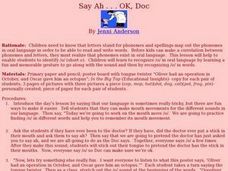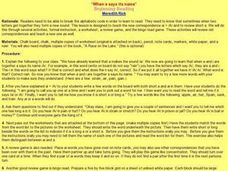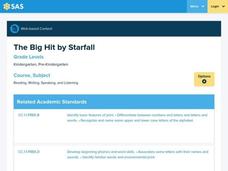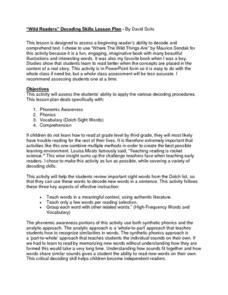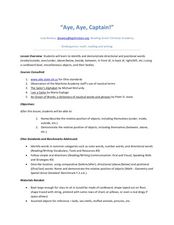Curated OER
Open Up and Say /o/
First graders listen to a variety of words to see if they can recognize the /o/ sound. They use letterboxes and letters discovering that each mouth moves gets its own box practicing forming words with the /o/ vowel sound. They then read...
Curated OER
Adam's Apples
Students examine the /a/ phoneme in both written and spoken words. They practice finding the /a/ in words, watch how their mouths move when making the sound, and write the letter. Next, they differentiate the sound in words, listen to a...
Curated OER
Hop Scotch
Students practice a variety of techniques and strategies to assess the letter sound of o=/o/. They encounter Elkonin Boxes to assist them with their task as well as the tongue twister "Oliver had an operation in October, and Oscar gave...
Curated OER
Say What?
Students explore phonemes in spoken words. They discuss the /e/ (short e) correspondence. Students read "Red Gets Fed." They learn a meaningful letter symbol for the /e/. Students identify /e/ sound in both spoken and written words.
Curated OER
Around the World with Bud the Sub
First graders review the recently taught vowel /o/. They then form the sound for /u/ telling whether it is a closed or open vowel sound and repeat it several times together. They practice a /u/ tongue twister saying it together and...
Curated OER
Icky Sticky
First graders the /i/ sound by practicing the way the mouth moves while making the sound while saying "icky, sticky." They write the letter "i" using both upper and lower case letters, make words using letterboxes, and write about a...
Curated OER
Crying Baby
Students practice techniques and strategies with phonics, spelling and word recognition with the sounds of /a/. They read and work on this task with the book, "Cat Nap," and the tongue twister "Alice asked if Annie's active animals were...
Curated OER
Ehhh! Can you repeat that!
Students assess how to recognize phonemes that stand for letters creating spoken words utilizing the short vowel /e/. They associate our written language as a secret code to solve. The tongue twister "Everybody saw Eddie and the Eskimo...
Curated OER
Say Ah . . . OK, Doc
Students distinguish between letters that stand for phonemes that deal with the short /o/ sound. They study how spellings map out the phonemes in oral language in order to be able to read and write words. Each student practices the...
Curated OER
Ah Ah Ah! Don't Do That!
Students become familiar with the alphabetic principle that letters stand for phonemes and spellings map out the phonemes in spoken words. They focus on identifying the short /o/ sound in spoken words and the tongue twister "Oscar Otter...
Curated OER
When A Says Its Name
Students are introduced to the concept of vowel digraphs. They identify the digraph /ai/ in spoken language. After a brief discussion, students apply the rule for reading and spelling words containing the /ai/ digraph by playing word bingo.
Curated OER
The Big Hit
Students are introduced to the phonetic sound associated with the short letter "i" and listen to a story which includes words with this sound. For this the big hit starfall lesson, students build sound letter accuracy. Students also...
David Suits
“Wild Readers” Decoding Skills Lesson Plan
Set young readers on the path toward fluency with this phonemic awareness resource. Based on the award-winning children's book, Where the Wild Things Are, this lesson allows beginning readers to practice isolating phonemes and...
Curated OER
First Day of School
Primary learners complete pre reading, writing, during reading, and interdisciplinary activities for the book First Day of School. They will complete journal entries, answer short answer questions, have discussions, and much more.
Curated OER
Picture Match
Students match pictures with words that have specific phonics connotations. For this picture matching lesson plan, students have groups of words with the same phonics sayings.
Curated OER
Icky-Sticky
Students practice recognizing the connection between phonemes and letters with an emphasis on finding the short vowel /i/ in words. They each receive a Elkonin letterbox and a picture card with icky-sticky gum on it and the letter i.
Curated OER
Voicing and Syllable Length (Using Rubber Bands)
Students identify voiced and unvoiced sounds. They practice using short and long vowel sounds. They identify consonants only after paying attention to the length of vowels. They use rubber bands to help them determine the difference...
Curated OER
Ashley's Apples
First graders compare the /a/ sound to that of a baby crying. They practice making the sound and then say the tongue twister as it is written on a sentence strip and then using the overhead and letters, name words with that sound in them.
Curated OER
Say Aaaaa for Apple
Young scholars say words by blending sounds and phonemes. They decode words in order to read and identify and understand the letter a. This phoneme /a/ is one of the short vowels that are needed to read and write. They will show...
Curated OER
The Fat Cat
Young scholars explore phonemes. They identify that a=/a/. Students recognize /a/ in spoken words by learning a meaningful representation and a letter symbol. Young scholars practice finding /a/ in a variety of words. Students read a...
Curated OER
Iggy and the Icky Sticky Inchworm
Students read and spell words. They have to recognize that letters stand for phonemes and spellings map out spoken words. Long and short vowels are hard to recognize and this lesson focuses on that. The short i is taught in the...
Curated OER
Grandpa Ed
Students engage in an emergent literacy lesson that focuses on phonemic awareness. For practice they become more comfortable with a short vowel phoneme, which can often be the most difficult to identify, by learning it in isolation.
Curated OER
Icky Fingers
Students are introduced to digraphs so they can match letters to their phonemes. They recognize the short vowel i=/i/ in both spoken and written words by practicing reading and spelling words containing /i/. Elkonin Letter Boxes are...
Curated OER
Aye, Aye Captain
Learners investigate how correspondences appear differently in different words. They also recognize the difference between long and short vowels. Students study how these correspondences are spelled and pronounced differently.










